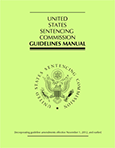 Overview of Federal Sentencing Guidelines
Overview of Federal Sentencing Guidelines
United States Sentencing Commission
The United States Sentencing Commission is an independent agency in the judicial branch of government. It establishes criminal case sentencing policies and practices for the federal courts. The Commission also advises and assist Congress and the executive branch to develop crime policy for the country. In order to do this the Commission collects and analyzes information about crime and sentencing in the federal courts. It uses this research to provide information to Congress and the PResident, and to formulate revisions to the Federal Sentencing Guidelines.
Federal Sentencing Guidelines Steps
In general the Federal Sentencing Guidelines take into account the seriousness of the crime and the criminal history, if any, of the offender. The sentencing guidelines provide 43 levels of offense seriousness, called Offense Levels. More serious crimes are assigned a higher offense level; while less serious crimes are assigned a lower offense level. The offense levels in the Federal Sentencing Guidelines were developed by the U. S. Sentencing Commission based on a review of pre-guideline average sentences for specific offenses.
Offense Level
In the Federal Sentencing Guidelines, each type of crime is assigned a base offense level, which is the starting point for determining the seriousness of a particular offense. Additionally, each federal criminal offense has a number of specific offense characteristics. These are factors that vary from offense to offense, but they can increase or decrease the base offense level which has a direct effect on the final sentence an offender receives under the federal sentencing guidelines. An example of such a factor is the amount of money involved in a theft or a fraud case. As the amount of money involved increases, the base offense level also increases to reflect the seriousness of the crime.
Adjustments to Offense Level
The Federal Sentencing Guidelines also contains provisions for making adjustments upward or downward in the base offense level based on the presence of certain factors. Categories of adjustments include: victim-related adjustments, the offender’s role in the offense, and obstruction of justice. Examples of adjustments in the federal sentencing guidelines are as follows: A decrease in levels where the offender is only a minor or minimal participant in the offense; an increase in offense level where the victim is particularly vulnerable (elderly person or child); an increase in the offense level where the offender obstructs justice.
Criminal History
The Federal Sentencing Guidelines assign each offender to one of six criminal history categories based upon the extent of an offender’s past misconduct. Criminal History Category I is the least serious category and includes many first-time offenders. Criminal History Category VI is the most serious category and includes offenders with serious criminal records.
The Sentencing Table and the Guideline Range
The Federal Sentencing Guidelines contains a chart which contains the various offense levels in a column on the left and the various criminal history categories across the top of the chart. Where the Offense Level and the Criminal History Category intersect on the chart is a listing of a recommended range of punishment set out in a months. Click here for a copy of the Federal Sentencing Guidelines Sentencing Table.
Adjustments to the Recommended Sentence Range – Departures & Variances
After the guideline range is determined, if here is some special circumstance that mitigates the case, a Criminal Defense Attorney can present arguments to the Court that the sentence should be lower than the sentence calculated under the Federal Sentencing Guidelines. If the argument is successful, the judge can impose a reduced sentence in the case as long as he puts his reasons in writing. These adjustments are known as either downward departures or variances in the sentence.
The Role of the Criminal Defense Attorney
Given the complicated nature of the Federal Sentencing Guidelines, it is crucial to have an experienced federal criminal defense attorney representing you in your case. A lawyer who is experience in handling federal criminal matters can assist you by making sure that you are not “overcharged;” a situation where the prosecution charges a more serious crime than is warranted from the facts. Additionally, your federal criminal defense attorney can ensure that any sentencing calculations are made in strict compliance with the Federal Sentencing Guidelines. Your lawyer should also research the facts and the law to determine what factors can be argued as reasons to lower the offense level, obtain a downward adjustment in the offense level, or obtain a departure or variance which could reduce your sentence.
William Bradford and Amber Ladner at Bradford Ladner LLP have practiced in federal court handling all manner of federal criminal charges for over 28 years. They understand the Federal Sentencing Guidelines and are experience in dealing with federal prosecutors and federal court judges. If you or a family member is facing a federal criminal charge we would be happy to meet with you to discuss how we can help. Please contact us today.



























